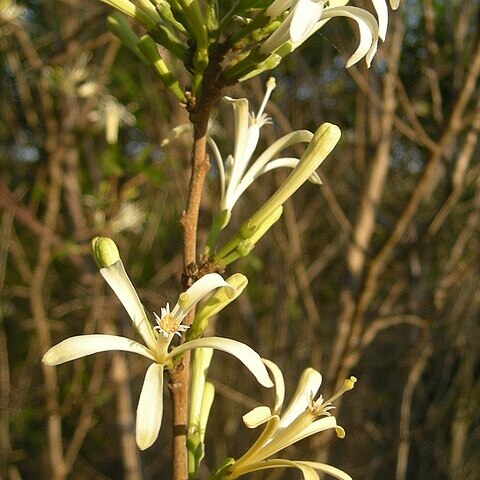Shrubs 2-3 m tall. Young branches brown, with longitudinal stripes, covered with yellow trichomes, glabrescent. Petiole usually 5-10 mm, yellow pubescent; leaf blade elliptic, ovate, or sometimes obovate, 5-10 × 2-4.5 cm, both surfaces pubescent especially when young, secondary veins 8-10 on each side of midvein and abaxially ± prominent, base cuneate to sometimes nearly rounded, margin entire or sometimes crenate to sinuous, apex acuminate to acute. Racemes axillary, corymbiform, 4-or 5-flowered; peduncle very short, pubescent; bractlets lanceolate, pubescent. Pedicel ca. 1.2 cm. Calyx campanulate, 2-3 mm, outside pubescent, 5-lobed, lobes triangular. Petals 5, white, distinct, linear to spatulate, 3-4.5 cm, apex acute. Staminal tube cylindric, long, thin, apex inflated and 4-or 5-lobed, lobes 1-2 × as long as anthers, glabrous, and tips usually 2-cleft; anthers 10, inserted below lobes of tube. Disk ca. 1 mm high, glabrous. Ovary short, 5-locular, with 2 anatropous ovules per locule; style long, exserted from filament tube; stigma ampuliform. Capsule globose, 1-1.5 cm in diam., 5-locular, with 1 seed per locule. Seeds oblong to ellipsoid, ca. 7 × 3 mm, ± curved and lunate. Fl. Apr-Jul, fr. Aug-Nov.
Deciduous straggling shrub or tree to 6 m tall. Leaves ovate to oblong, 1.5–10 cm long, 1–6 cm wide, rounded to cuneate at base, obtuse to acuminate at apex, subglabrous to subvelutinous abaxially; major veins c. 5 or 6 on each side; petiole 5–9 mm long. Flowers in condensed cymes, sweetly scented; pedicels 15–30 mm long. Calyx cupular, 3–4 mm long, pubescent, 5-lobed to ½ way. Petals linear-spathulate, 30–45 mm long, 2.5–4 mm wide at widest, white. Staminal tube cylindrical to weakly obconical, white, usually with 10 appendages, sometimes lobed; anthers 10. Ovary 5-locular; style long, exserted. Capsule globose, to 18 mm long, vermilion; valves 5, reflexed starwise in dehiscence. Seeds c. 6 mm long with shiny black testa.


